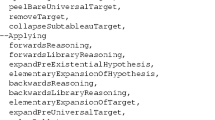Abstract
XBarnacle provides:
-
1.
An extension to the capabilities of CLAM, as not all theorems may be proved automatically, even with the provision of lemmas.
-
2.
A more useable version of CLAM, with potential to extend its user base.
-
3.
A tool for experimenting with different methods and heuristics.
Preview
Unable to display preview. Download preview PDF.
Similar content being viewed by others
References
R.S. Boyer and J.S. Moore (1979). A Computational Logic. Academic Press, ACM monograph series.
A. Bundy (1988). The use of explicit plans to guide inductive proofs. In R. Lusk and R. Overbeek (eds.), 9th Conference on automated Deduction, pages 111–120. Springer-Verlag.
A. Bundy, F. van Harmelen, C. Horn, and A. Smaill (1990). The Oyster-CLAM system. In M.E. Stickel (ed.), 10th Conference on Automated Deduction, pages 647–648. Springer-Verlag. Lecture Notes in Artificial Intelligence No. 449.
A. Bundy, F. van Harmelen, J. Hesketh, A. Smaill, and A. Stevens (1992). A rational reconstruction and extension of recursion analysis. In Sridharan, N. S. (ed.), Proceedings of the Eleventh International Joint Conference on Artificial Intelligence, pages 359–365. Morgan Kaufmann.
A. Ireland and A. Bundy, (1994). Productive use of failure in inductive proof. Journal of Automated Reasoning, 16.
D.A. Norman (1988). The Psychology of Everyday Things. New York: Basic Books.
Author information
Authors and Affiliations
Editor information
Rights and permissions
Copyright information
© 1997 Springer-Verlag Berlin Heidelberg
About this paper
Cite this paper
Lowe, H., Duncan, D. (1997). XBarnacle: Making theorem provers more accessible. In: McCune, W. (eds) Automated Deduction—CADE-14. CADE 1997. Lecture Notes in Computer Science, vol 1249. Springer, Berlin, Heidelberg. https://doi.org/10.1007/3-540-63104-6_39
Download citation
DOI: https://doi.org/10.1007/3-540-63104-6_39
Published:
Publisher Name: Springer, Berlin, Heidelberg
Print ISBN: 978-3-540-63104-0
Online ISBN: 978-3-540-69140-2
eBook Packages: Springer Book Archive




